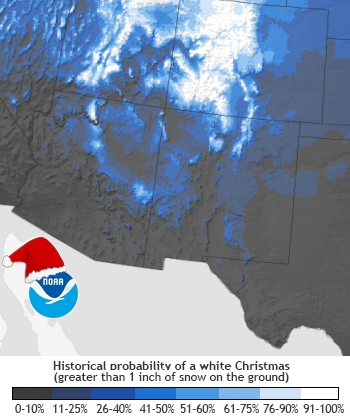 |
|||||||||||||||||||||||||||||||||||||||||||||||||||||||||||||||||||||||||||||||||||
|
Every year we receive inquiries regarding our chances for a "White Christmas." As you can imagine, the definition of a White Christmas can vary, depending on who you ask. For some, a solid snow cover on Christmas Day under bright blue New Mexico sunshine would qualify. For others, it means seeing snowflakes on Christmas Day, regardless of whether there's snow on the ground. And for the snow hounds, it means seeing snowflakes and having snow on the ground! |
|||||||||||||||||||||||||||||||||||||||||||||||||||||||||||||||||||||||||||||||||||
|
The chances for a White Christmas in Albuquerque and other lower elevation locations across central and northern New Mexico are not good, as shown in the image to the right produced by the National Centers for Environmental Information (NCEI). The image depicts the probability of having at least one inch of snow on the ground on Christmas Day. At the Albuquerque International Airport, for example, a Christmas snowfall (measurable) has occurred, on average, once every 16 years since snowfall records began at or near the airport (1931). You can check out the national probabilities from the National Centers for Environmental Information. Obviously, the higher in elevation and farther north you are in New Mexico, the better your chances for experiencing a White Christmas. But just how much better? The table below shows the various probabilities for a half dozen communities: Red River, Gallup, the Albuquerque International Sunport (ABQ), Clayton, Chama and Roswell. |
 |
||||||||||||||||||||||||||||||||||||||||||||||||||||||||||||||||||||||||||||||||||
|
|||||||||||||||||||||||||||||||||||||||||||||||||||||||||||||||||||||||||||||||||||
|
It's important to note that the period of record varies among these stations, which makes it difficult to make accurate comparisons. However, generally speaking, winter storms that track across central or southern New Mexico, and tap low level moisture from the Gulf of America, tend to produce the heaviest and most widespread snows, particularly over the eastern plains. This may explain the fact that the probability of seeing snowflakes in Roswell is slightly better than in Albuquerque. |
|||||||||||||||||||||||||||||||||||||||||||||||||||||||||||||||||||||||||||||||||||
|
What's the forecast for your location on Christmas Day this year? |
|||||||||||||||||||||||||||||||||||||||||||||||||||||||||||||||||||||||||||||||||||
|
The 2017 Christmas Day snow cover, as well as the Christmas Day snow cover since 2005, is depicted in the charts below. Snow cover Christmas 2017 was sparse, with the only snow cover in the San Juan Mountains. Snow cover in December 25, 2016 was mostly in the northwest and north central mountains, which had a decent snow pack building. Lighter snow cover existed over the western high terrain, particularly on the Chuska Mountains. Snow cover was limited to the northern mountains and adjacent northeast highlands in 2014, with more of the state seeing a white Christmas in 2013 and 2012. December 2011 was an active month, with winter storms early in the month and in the week prior to Christmas day, such that much of New Mexico was treated to a white Christmas. 2011 was the last year when snow covered the ground over a vast majority of the state. Snow on the 23rd and 24th of 2009 also resulted in much of the state having a white Christmas. Christmas Day 2008 had two feet or more of snow over the northern and western high terrain, while in 2007 snow cover was confined to the western and northern mountains. In 2006 Christmas Day fell between two major snow storms in New Mexico. Widespread snow coverage of less than 2 inches remained on Christmas Day. Christmas Day 2005 had only limited areas over extreme northern New Mexico with snow on the ground. These charts also help to show that for New Mexico, the higher the terrain, the greater the chance of at least one inch of snow on the ground. For most of the high elevations, the chances of snow on the ground (50 to 80%) exceed the chances of seeing it snow (15 to 20%). For locations at lower elevations, such as Albuquerque, Roswell, Clovis and Gallup, the probability of seeing snow (4-15%) slightly exceeds the chances of having an inch of snow on the ground (2-13%).
|
|||||||||||||||||||||||||||||||||||||||||||||||||||||||||||||||||||||||||||||||||||
12/25 Snow Cover 2004 - 2017
|
|||||||||||||||||||||||||||||||||||||||||||||||||||||||||||||||||||||||||||||||||||
|
The figures above were obtained at the NWS National Operational Hydrologic Remote Sensing Center. At this site, you can monitor snow coverage, snow depth and snow water equivalent. Visit the web site and generate your own images for different areas of the county or for any day since 2002.
Here are the "Snow on Christmas" events at and near the Albuquerque International Airport since official record-keeping began in 1892:
|
|||||||||||||||||||||||||||||||||||||||||||||||||||||||||||||||||||||||||||||||||||